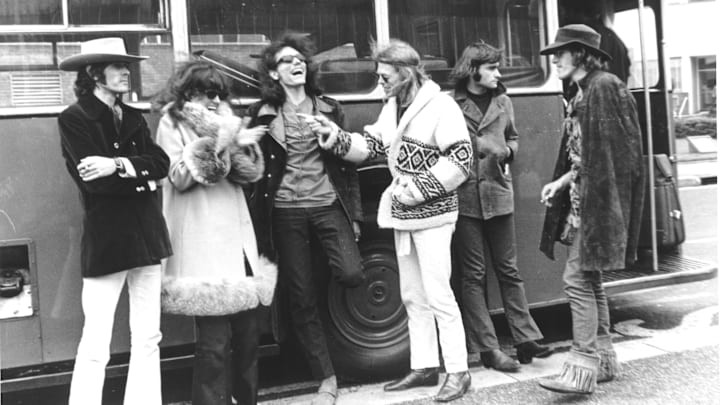If you just check your dictionary, old dusty big book, or its online version, the definition of Flower Power reads quite simply, “A nonviolent ethic as advocated by hippies.” Yet, things were much more complicated than that. While the term includes deeper social elements the whole thing was based around the music created in the late sixties and early seventies, primarily coming from San Francisco.
And it was a widespread musical net, that did not just include what would strictly fall under psychedelic rock, but included so many other musical elements from folk and blues to anything experimental.
In many ways, San Francisco and its Haight-Ashbury district were the epicenter of the movement, and quite a bit of music created at the time remains not only to ‘Flower Power,’ but to the development of modern music in general. Here are nine albums created by artists based in San Francisco at the time that are quite essential for any discerning collection.
Nine Flower Power era albums that are essential for every music lover
Jefferson Airplane - Surrealistic Pillow (1967)
Probably one of the most influential bands of the period with this, the band’s second album, definitely being one of their strongest offerings, if not the best one. The combination of folk and blues turned into a great slice of psychedelia and equally great lyrics, with the dual vocals of Grace Slick and Marty Balin behind some exemplary playing, remain as fresh and exhilarating as it was back in 1967.
Moby Grape- Moby Grape (1967)
Possibly one of the greatest debut rock albums of all time with a brilliant set of songs, with practically every then member of the band contributing both with songwriting and vocals.
An excellent blend of almost everything that was in the ears at the time from folk and blues to country and rock, never dropping in quality at any point. Unfortunately, it was hard to follow when you immediately hit the top, with the band’s follow-up albums having great stuff but never matching this debut.
Quicksilver Messenger Service - Quicksilver Messenger Service (1968)
Another great debut album, with guitarist John Cipollina showing all that he has got (then lead singer Dino Valenti being in jail while the album was recorded). Their psych-infused combination of blues and folk shone through, even though they didn’t stretch as much in the studio as they did live. Still, it is surely the band’s strongest all-studio effort that still sounds great.
Steve Miller Band - Sailor (1968)
Before Miller turned into an FM radio (and chart) sensation in the seventies, he fronted his psych band (that early on included one Boz Scaggs) that here sounded like early Pink Floyd playing the blues with Miller in full form on all fronts. It was an excellent precursor of what was to follow from Miller (an early version of “Gangster of Love”), but also included great psych gems like “Dear Mary.”
Big Brother & Holding Company - Cheap Thrills (1968)
Billed under a band name if for nothing else, this album should be here because it formally introduced Janis Joplin to the world. Yet, it was not only Joplin’s bluesy, raspy vocal bravados (and songwriting) that stood out but the band's excellent backing and Robert Crumb’s iconic album cover that stood out.
Soon after Joplin left to go solo, and the band somehow fell into the shadows, deservedly or not, possibly it was so hard to play without Joplin’s mercurial presence.
Mad River - Mad River (1968)
If there ever was a precursor to heavy psych rock then it was this band and their self-titled debut album. Dark, with jagged edgy playing, the band immediately became cult faves that included poet/writer Richard Brautigan.
The album became more influential among other artists than it had success, with lead songwriter Lawrence Hammond switching gears and turning to country rock for the band's second (ultimate) album and his solo efforts.
KAK - KAK (1968)
Gary Lee Yoder and his crew came up with just this sole album, yet it turned out to be one of the key references for jam bands that were to crop up later on. Mostly relaxed, spaced-out cool, particularly exemplified in “Lemonade Kid,” the key track here, the band picked up references from practically everybody that meant something on the San Francisco scene at the time.
Santana - Santana (1969)
Bringing Latin vibes into psychedelia, with an exemplary band and some inimitable guitar licks from Carlos Santana it not only brought fresh air into the San Francisco scene, but it was an album that exemplified the diversity of music at the time. It was also a pure example of how far jam rock can go, and here it went quite far.
Grateful Dead - American Beauty (1970)
This one came at the tail-end of both ‘Flower Power’ and San Francisco as a musical epicenter, turning out to be an acoustic masterpiece and along with its companion album (Workingman’s Dead) released the same year Grateful Dead’s strongest studio album. At the same time, it produced countless gems and core repertoire for the band’s ever-evolving live shows.
